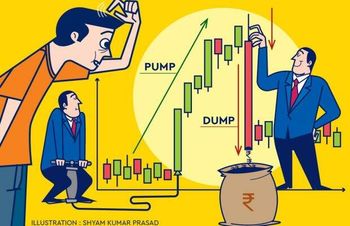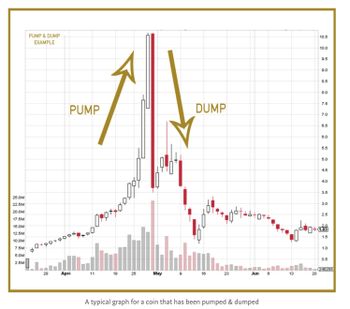⚠️ The dark side of Stock Market: Pump And Dump Scams ⚠️
The stock market is a place where people are eager to pay 100 rupees for a 10 rupee stake but are hesitant to pay 10 rupees for a 100 rupee share. Everyone who has spent any time in the stock market has heard about penny stocks and their pump and dump stories.
🤔 What is the pump and dump scam?
A pump-and-dump is a two-part manipulative scheme. The pump component involves increasing the stock price artificially through false and deceptive recommendations. The dump phase entails selling or unloading the stock at an inflated price.
🌟 Let's understand this with an example:
For instance, an operator holds 1,00,000 shares of a company at Rs 5. Now he decides to pump the company's shares so that he can sell them at a higher price.
He'll start circulating fake information about the company. He might predict, for instance, that the company will be awarded a $50 million contract the next week or that an industry leader will buy it. Maybe none of this news is accurate. However, his plan is to raise interest in the stock. More people will begin purchasing firm shares as word gets out. The share price will increase gradually over a short period of time by 20, 30, or even 100%.
He will sell the shares at the inflated price once the stock price has increased noticeably, let's say to Rs 14. In the process, he will earn a sizable profit.
🤔 Why Do Operators Target Penny Stocks(Small Companies) For Pump-And-Dump Schemes?
Operators target small and penny stocks. This is because manipulating these companies is much easier for the following reasons:
⚈ Their trade volumes are minimal.
⚈ The public has restricted access to company information.
⚈ Typically, a few research analysts would follow such companies or produce detailed analyses.
🤔 What Is SEBI Doing To Address The Pump And Dump Scams?
The Securities and Exchange Board of India's (SEBI) (India's capital market regulator) major mission is to prevent market manipulation.
The SEBI employs a three-pronged strategy to combat the pump-and-dump issue.
1. Surveillance:
SEBI closely monitors the financial performance of businesses.
The corporate Finance Investigation Department is a distinct watchdog unit inside it. Using this, SEBI attempts to discover any misconduct and also takes preventative action.
2. Prevention:
SEBI's preventative plan has involved interventions we never imagined. Scammers use SMS. SMS is a popular and easy way to send stock tips. SEBI urged TRAI to design software to stop the problem. The software can prevent pump and dump operators' by identifying specific keywords.
3. Education:
SEBI takes a no-nonsense attitude to pump-and-dump schemes. A recent example of this was when it requested that Patanjali management place advertisements in national publications in order to discredit an SMS that circulated during the Ruchi Soya Follow-On Public Offer (FPO).
The SMS attempted to entice retail investors to subscribe to the Ruchi Soya (FPO) by emphasising a potential 30% reduction on the issuance price versus the market pricing. Aside from media advertisements, SEBI required Patanjali to provide investors with a window to rescind their FPO bids. This was the first time SEBI took such an action.
🧠💡 The million-dollar question now is how to recognise pump-and-dump tactics? 💡🧠
You can follow these four steps:
Step 1: Be Highly Skeptical of Unsolicited Investment Offers.
A comment, tweet, email, or WhatsApp message can get you access to today's investment pitches. The source of the communication is frequently ambiguous.
Therefore, you should generally ignore all such messages.
Step 2: Look Out For Obvious Red Flags
⚈ Promises of very high investment returns
⚈ Cases where pressure is being exerted as a limited opportunity
⚈ Any claims being made that the recommendation is based on insider or confidential information
Step 3: Look Out For Promotional Stuff
Many content creators on platforms like YouTube, Twitter, Instagram, etc. can influence their viewers and followers. As an investor, it is important that you pay close attention to the disclosures when these content makers discuss or advocate a certain stock or cryptocurrency.
Step 4: Conduct Your Research And Due Diligence Before Investing
Before investing as an investor, you should undertake study and due diligence. If you are too busy or do not have the time to conduct research, you can invest through a mutual fund.
🌟 There ain’t no such thing as a free lunch. This popular saying says that you can't get something for nothing. If you remember this as an investor, you can easily stay away from schemes like "pump and dump" and others like it.
🌟 Always invest in companies which are doing good business and generating good revenues over time. And if you don't have time to invest in research then you can simply invest in mutual funds or Nifty 50 Companies like Reliance, AsianPaints, HDFC, HDFC Bank, etc.
⚠️ Disclaimer ⚠️
The information shared above is only for educational purposes. Please consult your financial advisors before making any investment decision.
Do share your views/queries in the comment section.
❮
❯

